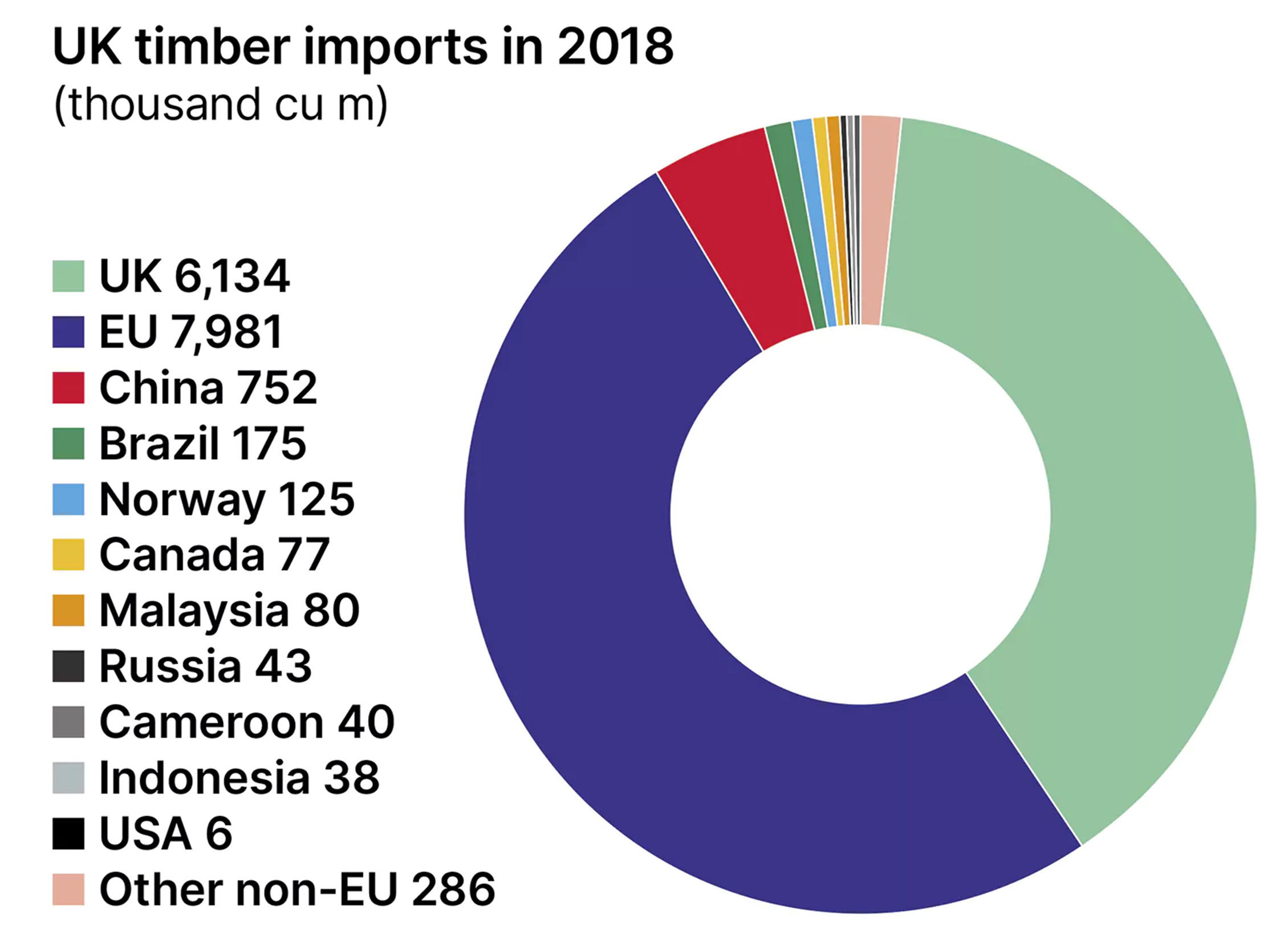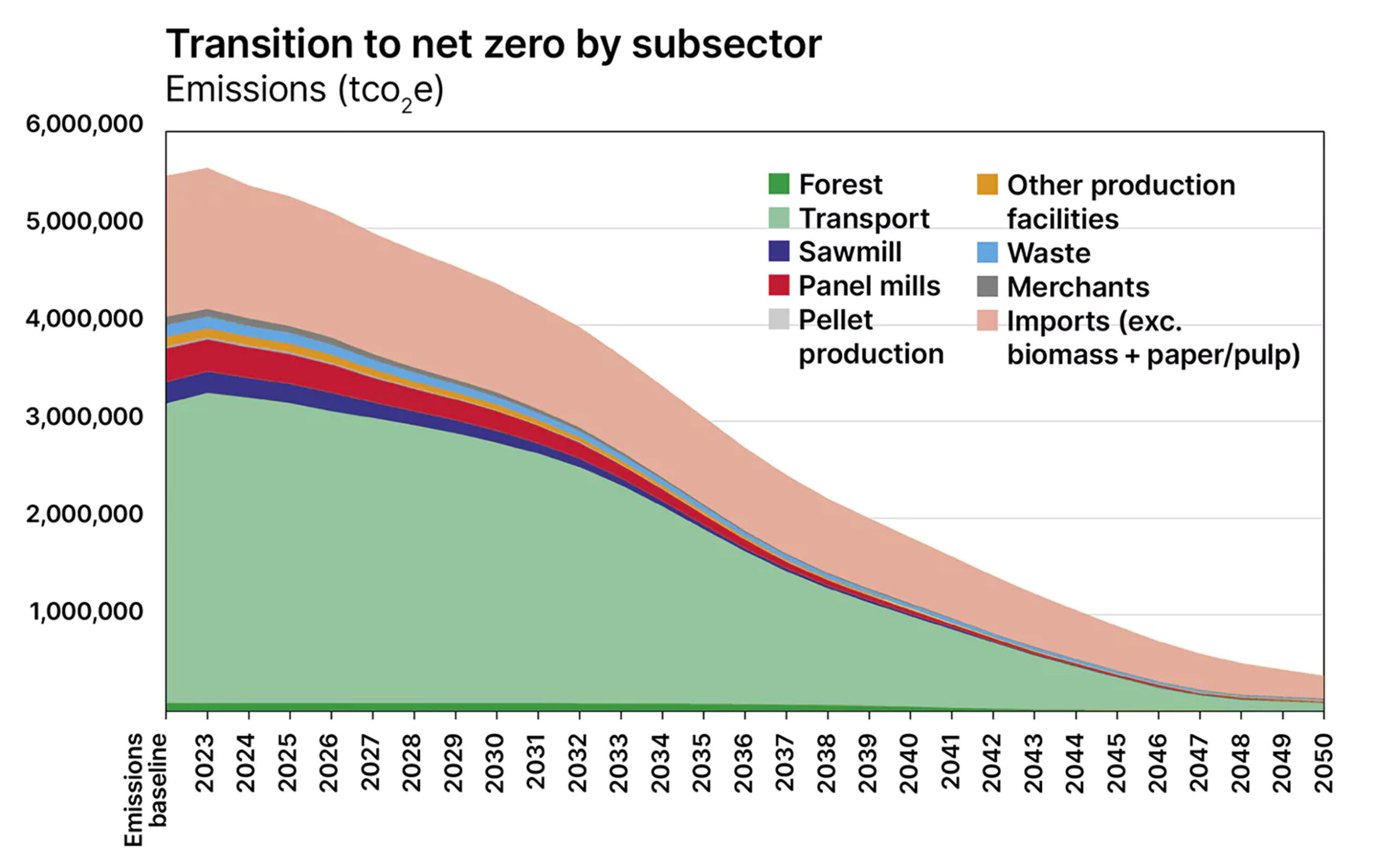THE UK is the second largest net importer of timber after China. Forest Research figures show that, of the 15.8m cu m of timber consumed in the UK in 2022, almost 9.7m cu m (61%) was imported, mainly from northern Europe.
However, it is estimated that about 80% of the construction industry’s requirements are being met by these imports, meaning much of our UK-grown resource is being used elsewhere. To ensure we have access to enough timber to meet the growing demand for timber-framed structures going forward, we need to increase the supply and use of our UK-grown resources.
According to the State of Europe’s Forests 2020 report and Forest Research’s 2022 data, currently only around 63-67% of the UK net annual increment (NAI) is felled. The NAI is the net annual volume of timber available to harvest, considering any natural losses. The timber available to harvest is predicted to increase by around 20% by 2039, before falling back to current levels.
Government targets to increase tree planting mean we will also have more timber available for construction over the long term. All this suggests at least a third more of our UK-grown timber resource could be available for construction if the demand was there.
This stance is supported by the parliamentary Environmental Audit Committee, which stated that: “The long-term use of timber in construction offers longer-term carbon storage potential than other uses of harvested wood products and therefore has an important role to play in helping the UK to meet its net-zero targets. Domestically grown timber resulting from the current drive to plant must be available for use in construction as far as possible.”

In addition, according to the Timber Industry Net Zero Roadmap, 73% of the timber industry’s carbon footprint originates from embodied production emissions in imported material and the transport of these products to the UK. Using more locally grown materials means we will have greater control over the source, which will help decrease an asset’s embodied carbon footprint.
For example, James Jones and Sons, one of the largest, most efficient and innovative timber processing groups in Europe, is trialling the use of electric HGVs to move timber products between its sites, helping to reduce the embodied transport emissions in its UK-grown timber.
Responsible sourcing: To ensure timber purchased is from responsibly managed woodlands in the UK, it is important to understand what to ask for. The UK government’s Central Point of Expertise on Timber (CPET), a body that provides advice to the public sector, developed the UK Timber Procurement Policy (UK TPP), which states:
Only timber and wood-derived products originating from an independently verifiable legal and sustainable source will be demanded for use on the government estate.
Appropriate documentation will be required to prove it. It applies to all virgin timber and wood-derived products used on the government estate, including temporary site works and material supplied by suppliers.
CPET also developed the government’s definition of legal and sustainable timber procurement, along with the two routes to demonstrate compliance with the UK TPP:
Category A Evidence – independent, third-party forest certification schemes: – Programme for the Endorsement of Forest Certification (PEFC).
– Forest Stewardship Council (FSC).
Category B Evidence – all other forms of evidence including: – UK Forestry Standard source (Grown in Britain [GiB] certification provides evidence of this). – Forest Law Enforcement Governance and Trade (FLEGT) licensed timber. – Compliance with the Framework for Evaluating Category B Evidence.
It is important to understand that Category A evidence is not better than Category B. However, only the PEFC, FSC and GiB schemes provide a full ‘chain of custody’ to the site of use. Responsibly sourced, legal and sustainable timber should be a pre-requisite of any timber procurement policy.

Specifying and procuring UK-grown timber: To meet local sourcing requirements of building certification schemes such as BREEAM, SKA and LEED, it is important to understand what timber products are available from the UK.
Softwood: Over half of all the timber consumed in the UK is sawn softwood, so this should be a key area of focus for timber specification. Of the UK resource of just under 3m cu m, it is estimated that a third is used for pallets, a third for fencing and the final third for construction.
Trees are a natural product, so their properties vary depending on the climatic conditions under which they grow. In the UK, coniferous trees like spruce grow very well, maturing in around 40 years. This makes excellent structural timber at strength class C16, suitable for most general construction applications like structural timber frames, floor joists, rafters and cut roof timbers, and internal partitions.
Coniferous trees in colder climates like the Nordic countries grow more slowly, coming to maturity in 60 years or more. This produces a higher proportion of timber meeting the properties of strength class C24/TR26 or higher – which makes them great for longer-span floor joists or trussed rafters. On average, the wholesale price of C16 timber is 10% less than C24.
To make the most efficient use of wood resources we need to use the whole range of wood products available, fully utilising both C16 and C24 timbers for the right situations. Timber Development UK (TDUK) publishes free span tables for C16 and C24 strength grades, so you can choose the right grade of timber for the right application.
For example, 45mm x 220mm C16 softwood timbers could be used as floor joists spanning up to 4.19m (assuming a dead load <0.25kN/sq m and imposed load <1.5kN/sq m), whereas 45mm x 220mm C24 softwood timbers would only span a little more, at 4.66m.
One UK manufacturer, Alexanders Timber Design, is also producing roof trusses from UK-grown C16 softwood rather than the C24/TR26 that is normally used.
The specification of a strength class does not imply any specific level of durability. Therefore, if C16 or C24 structural timber is to be used anywhere other than in a Service Class 1 construction environment, durability requirements will need to be specified. The easiest route to achieve such durability specifications will generally be by using factory-applied preservative treatments, usually to Use Class 2 for applications within the building envelope.
By specifying the right strength grade for the right application instead of overspecifying we can ensure we make the most efficient use of the finite sustainable softwood timber resource available to us.
Hardwood: Only around 5% of all timber consumed in the UK is sawn hardwood, of which only 3% comes from UK woodlands. A Grown in Britain WoodStock report found that more oak was used in the UK than all other hardwood species combined, making up a whopping 57% of all specifications. Utilising only one species of hardwood to this extent is not sustainable, and the report recommends an increased focus on UK grown hardwood resources and alternative species specified wherever possible.
Sheet materials: Much of the chipboard, OSB and MDF used in the UK is manufactured in the country, and these utilise many of the by-products from sawn softwood and hardwood processing that would otherwise go to waste.
For example, chipboard – used in everything from tongue-and-groove flooring to kitchen cabinets – incorporates both chip from the sawing of timber as well as post-consumer waste wood. OSB, on the other hand, uses the smaller-diameter thinnings from forests as well as the tops of sawlog trees.
As shown in the graphic at the top of this page, plywood isn’t manufactured in the UK. We should therefore consider specifying OSB as an alternative wherever possible, eg for roof sheeting or additional support within partition walls. There are now many different specifications of OSB that can be used for numerous applications.
Not only does this mean we use more of our homegrown resources, UK-manufactured OSB also has only a fifth of the embodied carbon of imported hardwood plywood. However, a growing percentage of this product is being sourced from non-UK and non-European sources, so be sure to check.
Summary: UK-grown timber can be used for many of the applications for which we currently use imported timber. By making informed choices, specifiers and purchasers can ensure that more of the timber used on their projects is locally sourced, which helps the UK economy and can lead to lower embodied carbon projects.
Charlie Law CEnv MIEMA ICIOB is founder and managing director at Sustainable Construction Solutions and sustainability director at Timber Development UK.



